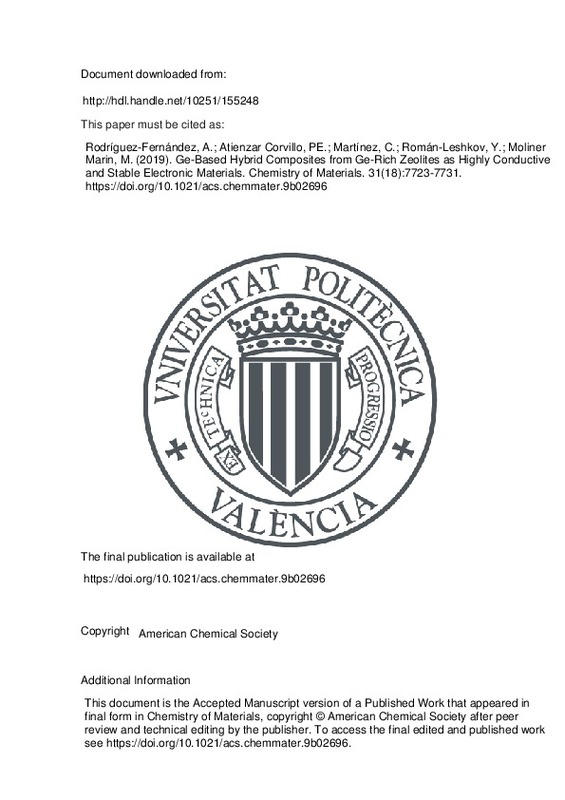JavaScript is disabled for your browser. Some features of this site may not work without it.
Buscar en RiuNet
Listar
Mi cuenta
Estadísticas
Ayuda RiuNet
Admin. UPV
Ge-Based Hybrid Composites from Ge-Rich Zeolites as Highly Conductive and Stable Electronic Materials
Mostrar el registro sencillo del ítem
Ficheros en el ítem
| dc.contributor.author | Rodríguez-Fernández, Aida
|
es_ES |
| dc.contributor.author | Atienzar Corvillo, Pedro Enrique
|
es_ES |
| dc.contributor.author | Martínez, Cristina
|
es_ES |
| dc.contributor.author | Román-Leshkov, Yuriy
|
es_ES |
| dc.contributor.author | Moliner Marin, Manuel
|
es_ES |
| dc.date.accessioned | 2020-11-18T04:31:55Z | |
| dc.date.available | 2020-11-18T04:31:55Z | |
| dc.date.issued | 2019-09-24 | es_ES |
| dc.identifier.issn | 0897-4756 | es_ES |
| dc.identifier.uri | http://hdl.handle.net/10251/155248 | |
| dc.description | This document is the Accepted Manuscript version of a Published Work that appeared in final form in Chemistry of Materials, copyright © American Chemical Society after peer review and technical editing by the publisher. To access the final edited and published work see https://doi.org/10.1021/acs.chemmater.9b02696. | es_ES |
| dc.description.abstract | [EN] Ge-containing zeolites were used as precursors for the synthesis of highly conductive and stable hybrid electronic materials by postsynthetic thermal treatment of the crystals in the presence of an olefin. Treating the as-prepared Ge zeolites in 1-butene at 700 degrees C formed a graphitic matrix within and outside the crystals due to the thermal degradation of the organic structure-directing agent inside the pores and the polymerization of the olefin. Importantly, these conditions forced Ge out of the framework, leading to the collapse of the crystalline structure and subsequent formation of metallic Ge nanoparticles distributed either as small, well-dispersed nanoparticles within the silica matrix or larger carbon-coated core-shell Ge@C nanoparticles on the external surface of the carbon-silica composite. Varying the zeolite topology influenced the size of the Ge@C nanoparticles, with those obtained using the multipore zeolite ITQ-22 (IWW, 12 x 10 x 8 rings) featuring smaller sizes (30-60 nm) than those obtained with the large-pore zeolite ITQ33 (ITT, 18 x 10 x 10 rings) (80-120 nm), where the lack of diffusional limitations increased metal sintering rates. The zeolite topology also influenced the final carbon content and dispersion of the Ge nanoparticles. The best performing Ge-based hybrid material was obtained by thermal treatment of ITQ-22 (Si/Ge = 4) at 700 degrees C in 1-butene. Unlike Ge-free hybrid controls, an ITQ L -22 (Si/Ge = 4) sample treated at 700 degrees C in 1-butene showed a conductivity value of similar to 2 S/m (measured at 1 V), which is in the range of a commercially available graphene. The simple methodology presented here is an alternative route for the efficient preparation of highly stable Ge-based hybrid composites with excellent conductivity for potential use as high-capacity electrodes. | es_ES |
| dc.description.sponsorship | This work has been supported by the Spanish Government through 'Severo Ochoa"(SEV-2016-0683, MINECO) and RTI2018-101033-B-I00 (MCIU/AEI/FEDER, UE) and by La Caixa Foundation through MIT-SPAIN SEED FUND (LCF/PR/MIT17/11820002). A.R.F. acknowledges the Spanish Government-MINECO for a FPU scholarship (FPU2017/01521). The Electron Microscopy Service of the UPV is acknowledged for their help in sample characterization. We thank Javier van Herpt for the cyclic voltammetry experiment. | es_ES |
| dc.language | Inglés | es_ES |
| dc.publisher | American Chemical Society | es_ES |
| dc.relation.ispartof | Chemistry of Materials | es_ES |
| dc.rights | Reserva de todos los derechos | es_ES |
| dc.subject | Composites | es_ES |
| dc.subject | Electrical conductivity | es_ES |
| dc.subject | Zeolites | es_ES |
| dc.subject | Nanoparticles | es_ES |
| dc.subject | Materials | es_ES |
| dc.subject.classification | QUIMICA ORGANICA | es_ES |
| dc.title | Ge-Based Hybrid Composites from Ge-Rich Zeolites as Highly Conductive and Stable Electronic Materials | es_ES |
| dc.type | Artículo | es_ES |
| dc.identifier.doi | 10.1021/acs.chemmater.9b02696 | es_ES |
| dc.relation.projectID | info:eu-repo/grantAgreement/MINECO//SEV-2016-0683/ | es_ES |
| dc.relation.projectID | info:eu-repo/grantAgreement/Fundació Bancària Caixa d'Estalvis i Pensions de Barcelona//LCF%2FPR%2FMIT17%2F11820002/ | es_ES |
| dc.relation.projectID | info:eu-repo/grantAgreement/AEI/Plan Estatal de Investigación Científica y Técnica y de Innovación 2017-2020/RTI2018-101033-B-I00/ES/DISEÑO DE CATALIZADORES MULTIFUNCIONALES PARA LA CONVERSION EFICIENTE DE BIOGAS Y GAS NATURAL A HIDROCARBUROS DE INTERES INDUSTRIAL/ | es_ES |
| dc.relation.projectID | info:eu-repo/grantAgreement/AEI//FPU2017%2F01521/ | es_ES |
| dc.rights.accessRights | Abierto | es_ES |
| dc.contributor.affiliation | Universitat Politècnica de València. Instituto Universitario Mixto de Tecnología Química - Institut Universitari Mixt de Tecnologia Química | es_ES |
| dc.contributor.affiliation | Universitat Politècnica de València. Departamento de Química - Departament de Química | es_ES |
| dc.description.bibliographicCitation | Rodríguez-Fernández, A.; Atienzar Corvillo, PE.; Martínez, C.; Román-Leshkov, Y.; Moliner Marin, M. (2019). Ge-Based Hybrid Composites from Ge-Rich Zeolites as Highly Conductive and Stable Electronic Materials. Chemistry of Materials. 31(18):7723-7731. https://doi.org/10.1021/acs.chemmater.9b02696 | es_ES |
| dc.description.accrualMethod | S | es_ES |
| dc.relation.publisherversion | https://doi.org/10.1021/acs.chemmater.9b02696 | es_ES |
| dc.description.upvformatpinicio | 7723 | es_ES |
| dc.description.upvformatpfin | 7731 | es_ES |
| dc.type.version | info:eu-repo/semantics/publishedVersion | es_ES |
| dc.description.volume | 31 | es_ES |
| dc.description.issue | 18 | es_ES |
| dc.relation.pasarela | S\406603 | es_ES |
| dc.contributor.funder | European Regional Development Fund | es_ES |
| dc.contributor.funder | Ministerio de Economía y Competitividad | es_ES |
| dc.contributor.funder | Fundació Bancària Caixa d'Estalvis i Pensions de Barcelona | es_ES |
| dc.contributor.funder | Agencia Estatal de Investigación | es_ES |







![[Cerrado]](/themes/UPV/images/candado.png)

